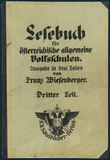School policies were a sensitive topic in the multi-ethnic Habsburg Empire. A particularly hot issue was the question of the language of teaching. Following the Austrian-Hungarian Compromise of 1867, the two halves of the Empire pursued very different objectives.
Constitutionally, the issue was clear cut. Article 19 of the December Constitution of 1867, concerning the equal treatment of all races of the Habsburg Monarchy in the field of schooling, laid down: "In the countries populated by several races, the institutions of public instruction shall be so organised that each race may receive the necessary instruction in its own language, without being obliged to learn a second language."
As so often, the difficulty lay in the details, since the ideal of actual complete equality of the individual languages that existed in the Habsburg Monarchy was never achieved, and the organisation of the school system reflected the general nationalities policies of the two halves of the Empire.
In the Austrian half of the Empire, two lines of development can be observed in educational policies. The centralistic approach of the pioneering age of the primary school system at the end of the 18th century continued to apply, with the result that German was at least to be cultivated as a second language even in non-German-speaking territories in the interest of ensuring a unitary state. In the middle and higher schools, German in any event had precedence as the language of teaching. This was less a question of the Germanisation of the non-German population but rather of the introduction of German as the standard language of communication and scholarship. In this respect, German was regarded as the lowest common denominator, since it was in any event already the most common language within the Monarchy. The unifying function of the German schooling system continued to be the ideal of the German liberal proponents of the idea of a unitary state.
This was opposed by the awakening peoples of the Habsburg Monarchy, who began to protest against the primacy of German. The federalist approach in school policies led to a nationalisation of the school system. Above all in the primary school sector, the provision prevailed that the language of teaching should be selected according to the majority of the pupils. As a result of the multi-ethnic composition of the Habsburg Monarchy, teaching at primary school was permitted in 14 languages, including Greek in the area of the military border, Armenian in Galicia and Hebrew in communities with a Jewish majority. The choice of the language of teaching was an autonomous decision by the local government authority as school provider. At local level, however, this liberal attitude was often prevented in reality by a bitter dispute over the language of the school, which above all in mixed language areas led to estrangement between the language groups.
At the level of the middle and higher schools, the opening of state grammar schools and higher schools with teaching in a language other than German was at times a political issue that was capable of developing into veritable state crises. The establishment of a university in their national language was for non-German speakers the ultimate proof of the achievement of their full potential as a nation.
The situation was different in Hungary, where school policies pursued a very different solution in the nationalities question. Educational legislation in Hungary, which regarded itself as the Magyar nation-state, was entirely dominated by a policy of Magyarisation. Thus, even teachers in non-Hungarian minority schools were required to have knowledge of Hungarian, and in non-Hungarian kindergartens and primary schools it was compulsory to teach the children the basic elements of Hungarian.
In higher schools, the Magyar claim to exclusivity was even more strongly marked. From 1875 on, only middle schools with Hungarian as the language of teaching were financed by the state, with the result that grammar schools in a different language had to be privately funded. With the exception of Croatia, which had also succeeded in maintaining a certain degree of autonomy in the educational sector, higher education was only accessible through the medium of Hungarian. As a consequence, the disadvantaged nationalities suffered a huge brain drain to the benefit of the Magyars, since many upward movers were often happy to accept the offer of integration into the Hungarian population in order to escape a hopeless existence within an underprivileged minority. A commitment to Hungarian was regarded as the ticket to social improvement and economic success.
Translation: David Wright
Hanisch, Ernst: Der lange Schatten des Staates. Österreichische Gesellschaftsgeschichte im 20. Jahrhundert [Österreichische Geschichte 1890–1990, hrsg. von Herwig Wolfram], Wien 2005
Křen, Jan: Dvě století střední Evropy [Zwei Jahrhunderte Mitteleuropas], Praha 2005
Seger, Martin: Räumliche Disparitäten sozioökonomischer Strukturen in der Spätphase der Habsburgermonarchie. Die Gleichzeitigkeit des Ungleichzeitigen, in: Rumpler, Helmut/Seger, Martin (Hrsg): Die Habsburgermonarchie 1848–1918, Band IX/2: Soziale Strukturen, Wien 2010, 27–44
Stourzh, Gerald: Die Gleichberechtigung der Nationalitäten in der Verfassung und Verwaltung Österreichs 1848 bis 1918, Wien 1985




